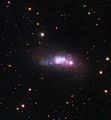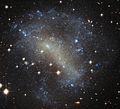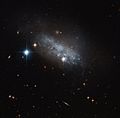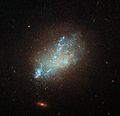Irregular galaxy facts for kids
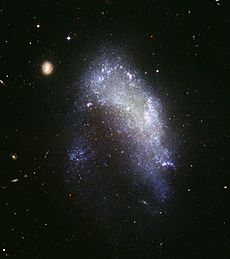
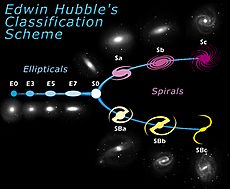
An irregular galaxy is a galaxy that does not have a distinct regular shape, like a spiral or an elliptical galaxy.
Irregular galaxies do not fall into any of the regular types of the Hubble sequence. They do not have a bulge in the centre, nor any trace of spiral structure. They are quite common: they may make up a quarter of all galaxies. Most were once spiral or elliptical galaxies but were deformed by gravitational pull. Irregular galaxies also contain abundant amounts of gas and dust.
There are three sorts of irregular galaxies:
- An Irr-I galaxy (Irr I) is an irregular galaxy that features some structure but not enough to place it cleanly into the Hubble sequence. Some of the irregular galaxies are small spiral galaxies that are being distorted by the gravity of a larger neighbour.
- An Irr-II galaxy (Irr II) is an irregular galaxy that does not appear to feature any structure that can place it into the Hubble sequence.
- Dwarf irregulars, This type of galaxy may be important, as they often have a low level of metallicity and relatively high levels of gas. This is similar to the earliest galaxies in the Universe. They may be a local (and recent) version of the faint blue galaxies known to exist in deep field galaxy surveys.
The Magellanic Cloud galaxies were once classified as irregular galaxies, but have since been found to contain barred spiral structures.
Images for kids
-
Blue compact dwarf galaxy ESO 338-4.
-
IC 4710 lies roughly 25 million light-years away in the southern constellation of Pavo.
-
NGC 2337 is an irregular galaxy that resides 25 million light-years away in the constellation of Lynx.
-
UGC 4459 is an irregular dwarf galaxy located approximately 11 million light-years away in the constellation of Ursa Major.
See also
 In Spanish: Galaxia irregular para niños
In Spanish: Galaxia irregular para niños


